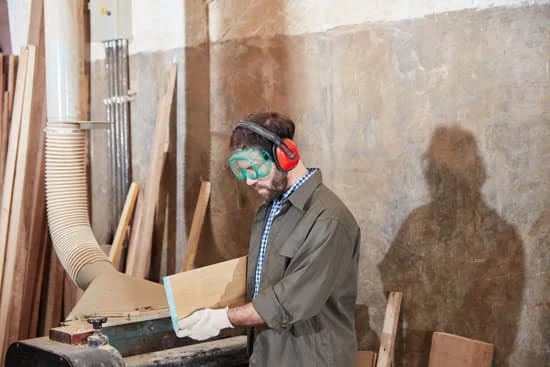Are you passionate about woodworking but struggle to find the perfect space to carry out your projects? In this article, we will explore how to make a woodworking workshop that meets all of your needs. From planning your space to organizing materials and implementing safety measures, we’ll guide you through the process of creating a functional and efficient workspace for all your woodworking endeavors.
Whether you’re a seasoned woodworker or just starting out, having a dedicated workshop can significantly enhance your productivity and enjoyment of the craft. Not only does it provide a designated area for you to work on projects, but it also allows you to customize the space according to your specific requirements. From equipment layout to storage solutions, having a woodworking workshop can make a world of difference in the quality of your work and overall experience.
In the following sections, we will delve into various aspects of setting up a woodworking workshop, including assessing available space, identifying essential tools and machinery, creating a functional workspace, organizing materials, implementing safety measures, managing sawdust with a dust collection system, personalizing the workshop, and maintaining its condition over time.
Whether you have an entire garage at your disposal or simply a corner in your basement, we will provide practical tips and advice on how to transform any space into the perfect woodworking workshop.
Planning Your Space
When it comes to creating a woodworking workshop, one of the first and most important steps is to plan your space. Assessing the available space and layout options will determine how efficient and functional your workshop will be. Here are some key considerations when planning the space for your woodworking workshop:
- Measure the available space: Before you start adding tools and equipment, measure the dimensions of your workshop area. This will help you determine what can fit in the space and how to arrange everything for optimal workflow.
- Evaluate layout options: Consider different layout options for your woodworking workshop based on the size and shape of the space. Think about where you will place workbenches, machinery, tool storage, and any other necessary furniture or fixtures.
- Create zones for different tasks: It’s important to designate specific areas within your workshop for various tasks such as cutting, sanding, assembly, and finishing. This will help you organize the space more effectively and improve productivity.
Once you have a clear understanding of your available space and layout options, you can start planning how to make a woodworking workshop that suits your needs and preferences. By carefully considering these factors, you can create a workspace that is not only functional but also comfortable and safe for all your woodworking projects.
Essential Tools and Equipment
When creating a woodworking workshop, it is essential to identify the necessary tools and machinery needed to set up a functional and efficient space. Whether you are a beginner or an experienced woodworker, having the right tools is crucial for producing high-quality work and ensuring safety in the workshop. Here are some essential tools and equipment that you will need:
- Power Tools: A table saw, miter saw, jigsaw, drill press, and router are among the essential power tools for any woodworking workshop. These tools will help you make precise cuts, create intricate designs, and drill holes with ease.
- Hand Tools: A set of chisels, hand planes, hammers, screwdrivers, and clamps are indispensable for fine woodworking tasks. These hand tools allow for more detailed and delicate work that cannot be achieved with power tools alone.
- Safety Equipment: Safety should always be a priority in any woodworking workshop. Essential safety equipment includes goggles or safety glasses, hearing protection, a dust mask or respirator, and sturdy work gloves.
- Machinery: In addition to power tools, larger machinery such as a planer, jointer, bandsaw, and lathe may be required depending on the type of woodworking projects you undertake.
When setting up your woodworking workshop, it is important to invest in high-quality tools that will withstand the test of time and provide consistent performance. While it may seem like a significant investment upfront, having the right tools will ultimately save you time and effort in the long run.
In addition to acquiring the necessary tools and equipment for your woodworking workshop, it is also crucial to consider proper maintenance and upkeep of these items. Regular tool maintenance not only extends their lifespan but also ensures optimal performance when working on your projects. By following manufacturer guidelines for cleaning, sharpening blades or bits, lubricating moving parts when necessary – unnecessary wear can be avoided prolonging their usability thus gettin best results.
Setting Up Your Workbenches
Choose the Right Workbench
When setting up your woodworking workshop, it’s important to choose the right workbench for your needs. Consider factors such as size, height, material, and weight capacity. There are various options available, including traditional wooden workbenches, steel workbenches, and custom-made workbenches designed to fit specific tools and machinery.
Positioning and Layout
Once you have chosen your workbenches, consider the positioning and layout within your workshop space. Arrange them in a way that allows for easy access to tools and materials while also maximizing workflow. It’s essential to leave enough space between each workbench to move around comfortably and safely.
Customizing Your Workbenches
Depending on the type of woodworking projects you undertake, you may need to customize your workbenches to suit your specific needs. This could include adding vices, clamps, bench dogs, or other accessories to improve functionality. Additionally, consider adding storage solutions such as drawers or shelving underneath the workbench to keep tools and supplies organized.
By carefully considering the type of workbench that best suits your needs, positioning them strategically within your space, and customizing them as necessary, you can create a sturdy and functional workspace that will enhance productivity in your woodworking workshop.
Organizing Your Materials
When it comes to organizing your materials in a woodworking workshop, having an efficient storage system is key to keeping your workspace neat and functional. Proper storage solutions not only help you maintain a clean and organized environment, but also make it easier to access the materials and supplies you need for your projects.
Assessing Your Storage Needs
The first step in organizing your materials is to assess the types and quantities of wood and other supplies that you typically work with. Consider the different sizes, shapes, and weights of the materials, as well as any specific storage requirements they may have. This will help you determine the best storage solutions for your workshop.
Storage Options
There are various storage options to consider when organizing your materials. For wood storage, you may opt for racks or shelves that can accommodate different lengths and types of wood. Additionally, drawers or cabinets could be used for storing smaller supplies such as screws, nails, and other hardware. Utilizing clear bins or containers can also make it easy to see and access smaller items while keeping them organized.
Creating a Functional Layout
Once you’ve identified your storage needs and options, it’s important to create a layout that maximizes space and efficiency in your workshop. Consider factors such as workflow, accessibility, and safety when planning the placement of your storage solutions. By strategically positioning your storage units within arm’s reach of your workbench or machinery, you can streamline your processes and minimize disruptions during projects.
By implementing an effective storage system for your woodworking workshop, you can ensure that all your materials are readily available when needed, contributing to a more productive and enjoyable crafting experience.
Safety Measures
Safety is a top priority in any woodworking workshop, and implementing safety protocols and best practices is crucial to ensuring a secure and productive workspace. One of the first steps in establishing a safe woodworking environment is to invest in high-quality personal protective equipment (PPE), such as safety goggles, hearing protection, and dust masks. It is essential for woodworkers to wear PPE at all times while operating machinery or handling materials to prevent injury.
Additionally, it’s important to educate yourself and anyone else working in the workshop about proper tool usage and safety procedures. This includes understanding the correct way to operate each piece of equipment, as well as how to safely handle and store tools when they are not in use. Conducting regular safety training sessions can help ensure that everyone in the workshop is aware of potential hazards and knows how to mitigate risks.
Another key aspect of maintaining a safe woodworking workshop is keeping the space clean and organized. Cluttered work areas can pose tripping hazards, and sawdust buildup can increase the risk of respiratory issues. Implementing regular cleaning routines and investing in a dust collection system can greatly reduce these risks. By managing sawdust effectively, woodworkers can maintain a clean and safe environment for themselves and others in the workshop.
By prioritizing safety measures such as providing adequate PPE, conducting regular safety training, keeping the workspace clean, woodworkers can create a safer environment for themselves and their colleagues. When considering how to make a woodworking workshop, it’s important to establish solid safety protocols that prioritize accident prevention and overall well-being.
Creating a Dust Collection System
Woodworking can be a messy business, and one of the biggest challenges is managing the sawdust that comes with it. Setting up an effective dust collection system is crucial for keeping your workshop clean and maintaining a healthy work environment. There are several options for achieving this, from portable dust collectors to centralized systems that connect to multiple machines.
The first step in creating a dust collection system is to assess your space and choose the best option for your workshop. Consider factors such as the size of your workspace, the type of woodworking you do, and the power requirements of your equipment. Portable dust collectors are ideal for small workshops, while larger, centralized systems are better suited for larger spaces or heavy-duty woodworking.
Once you have chosen the right type of dust collector for your workshop, it’s important to properly install and maintain it. This includes positioning the collector near each machine it will serve, using proper fittings and hoses to connect the machines to the collector, and regularly emptying and cleaning out the collection bags or canisters. Additionally, investing in air filtration systems can further improve air quality by capturing fine particles that may escape from the dust collector.
| Option | Consideration |
|---|---|
| Portable Dust Collectors | Ideal for small workshops |
| Centralized Systems | Suited for larger spaces or heavy-duty woodworking |
| Air Filtration Systems | Improve air quality by capturing fine particles |
By implementing a well-designed dust collection system in your workshop, you can significantly reduce airborne sawdust, minimize cleanup time, and create a healthier environment for yourself and others who share your workspace. With proper maintenance and upkeep, you can ensure that your woodworking workshop remains clean, safe, and efficient for years to come.
Overall,enabling an effectiv e uct colection system will enable workers complain about breathing related problems.
Personalizing Your Workshop
Creating a woodworking workshop is an exciting and fulfilling endeavor, but personalizing your space can take it to the next level. Adding finishing touches and making it your own can enhance your workshop’s functionality and aesthetics. Here are some tips on how to personalize your woodworking workshop.
One way to make your workshop feel like your own is by adding personal touches, such as artwork or decor that reflects your style and personality. This could be anything from vintage woodworking posters to custom-made signs with your shop’s name. These small details can make a big difference in creating a space that feels uniquely yours.
Another way to personalize your workshop is by customizing the layout and organization to fit your specific needs. This could involve adding extra storage solutions for tools or materials, creating designated areas for different types of projects, or even incorporating a comfortable seating area for relaxation or brainstorming.
Furthermore, consider investing in quality lighting that not only illuminates your workspace effectively but also adds ambiance to the environment. Good lighting not only makes it easier to work on intricate woodworking projects but also contributes to the overall atmosphere of the workshop.
| Tips for Personalizing Your Workshop | Details |
|---|---|
| Add personal touches | Decor, artwork, custom-made signs |
| Customize layout and organization | Extra storage, designated project areas, comfortable seating |
| Invest in quality lighting | Effective illumination, adds ambiance |
Maintenance and Upkeep
In conclusion, creating a woodworking workshop can be a rewarding and fulfilling endeavor for any woodworking enthusiast. By following the tips and guidelines provided in this article, you can successfully set up your own woodworking space and pursue your passion for creating wooden masterpieces.
Once you have established your woodworking workshop, it is important to prioritize maintenance and upkeep to ensure that your space remains organized, functional, and safe. Regularly inspecting and maintaining your tools, machinery, workbenches, and storage solutions will help prevent accidents and prolong the lifespan of your equipment. Additionally, implementing a regular cleaning schedule and dust collection system will contribute to maintaining a clean and healthy workspace.
By personalizing your workshop with finishing touches such as artwork, decor, or additional features that complement your style of woodworking, you can create a welcoming and inspiring environment. Finally, continue learning about new techniques, tools, and safety measures to enhance your skills as a woodworker while keeping your workshop in top condition. With dedication and attention to detail, you can enjoy many years of productive and enjoyable woodworking in your well-maintained workshop.
Frequently Asked Questions
What Do I Need to Start a Wood Workshop?
Starting a wood workshop requires some key essentials. First, you’ll need a dedicated space with proper ventilation and lighting. You’ll also need essential tools such as a saw, drill, sander, and workbench. Safety equipment like goggles, gloves, and a dust mask are crucial too.
How Do You Plan a Woodworking Workshop?
Planning a woodworking workshop involves several steps. First, assess your space to determine the layout for your tools and workstations. Then, consider what projects you want to undertake and organize your tools accordingly. It’s important to have a clear plan for safety measures and storage solutions as well.
How Do You Set Up a Woodworking Station?
Setting up a woodworking station begins with organizing your tools in accessible locations. Your workbench should be sturdy and at a comfortable height for working on projects. Additionally, consider adding task lighting to illuminate your workspace effectively. Finally, ensure your station has adequate ventilation to manage wood dust and fumes.

Hi everyone! I’m a woodworker and blogger, and this is my woodworking blog. In my blog, I share tips and tricks for woodworkers of all skill levels, as well as project ideas that you can try yourself.





